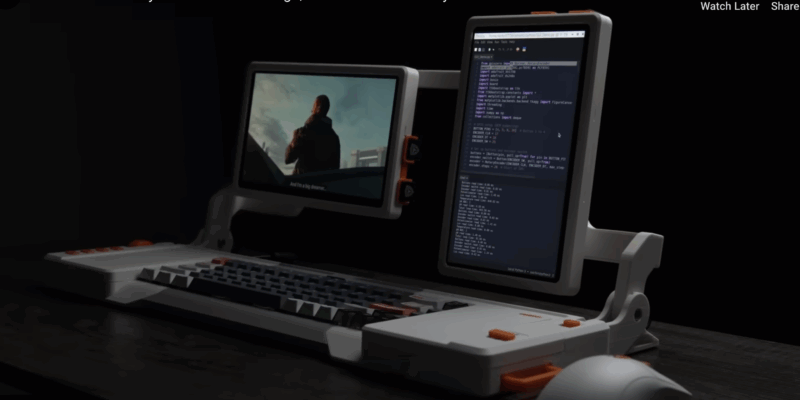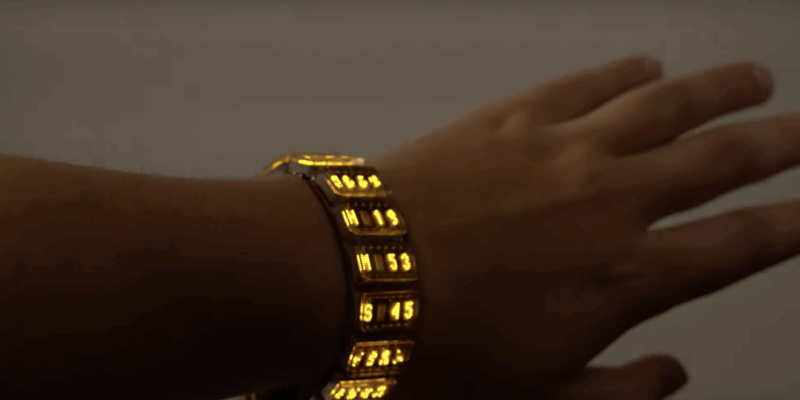CrowPi2 review – Raspberry Pi laptop and learning kit
By Lucy Hattersley. Posted

CrowPi2 (£231/$300) took us completely by surprise when it landed on our desk. We never tested the original CrowPi ($229) which was a touchscreen and electronics kit. Our CrowPi2 review explains why we think this is a great electronics learning kit..
Advertisement
Starter electronics: how to build and program circuits with a Raspberry Pi or Raspberry Pi Pico.
CrowPi2 is is a huge step up in ambition. The touchscreen is replaced with a full IPS display, keyboard, and a trackpad with mouse combo, turning the CrowPi learning environment into a laptop.
At the time of writing, CrowPi2 is in the last days of a successfully funded Kickstarter campaign, and the device will head to the Elecrow store shortly. The price reflects the Kickstarter and shipping cost.
There are three versions available: a Basic kit that contains the CrowPi2, a Starter Kit (which we are reviewing here) which also comes with a Raspberry Pi 4 with 4GB RAM, and an Advanced kit which comes with a 128GB microSD card and a few extra sensors.
The CrowPi2 itself is a plastic laptop clamshell with an 11.6-inch 1920×1080 IPS screen and a wireless keyboard (which can be removed from the housing and used separately). The case also comes with a 2MP camera, speakers, and a headphone jack. And a lot, lot more.
The CrowPi2 Development board
The real magic for CrowPi2 begins when you lift out the removable keyboard and take a look at the Development board beneath.

On the Development board you’ll find [“deep breath” – Ed]:
-
Thumb joystick
-
Segment display
-
Relay
-
LED
-
DHT11
-
Tilt switch
-
LCD
-
PIR motion sensor
-
Sound sensor
-
IR receiver
-
I/O interface
-
Servo interface
-
Step motor interface
-
8×8 button matrix
-
Buzzer
-
Vibration motor
-
Touch sensor
-
8×8 RGB LED matrix
-
Light sensor
-
Ultrasonic sensor
Alongside all that is a 40-pin GPIO socket and breadboard with a GPIO toggle switch that you can use to connect/disconnect all the components on the Development board and use pure GPIO I/O as regular.
There’s also a Raspberry Pi cooling fan (permanently on).
To be clear. This isn’t the list of components in the box. That’s just the permanently fixed electronics kit on the CrowPi2 Development board.
All the extra kit in the CrowPi2 box
The box contains a further 31 modules [“deep breath” – Ed], including:

-
IR remote controller and receiver
-
Stepper motor
-
Servo
-
SDC motor with mini fan
-
RFID card and tag
-
NFC card
-
Moisture sensor
-
Components pack (we see jumper wires, resistors, buttons, LEDs, a potentiometer, diodes, and capacitor.)
-
Two game controllers
-
Two 32 microSD cards: one with the custom Raspberry Pi OS system and another set up for RetroPie so you can quickly play games with the two controllers.
-
Minecraft paper cut-outs to assemble (to make boxes and other elements from the game)
-
User manual. Elecrow promises a Python and Scratch programming book to follow.
Honestly, it’s baffling the amount of electronics kit that’s on display here.
Learn code and electronics with CrowPi2
All this would mean little if it was simply components slung in a box. Thankfully, CrowPi has spent a lot of time honing version one, and CrowPi2 is a very well-rounded learning platform.
Our unit came with the Raspberry Pi 4 and a customised version of Raspberry Pi OS pre-installed. Setup was a case of plug in and turn on. We disassembled Raspberry Pi 4 from the case and fitted it back in to test the process, and it was very easy.
A custom version of Raspberry Pi OS boots into a friendly interface with links to projects, learning materials and various other friendly welcome features like Minecraft and AI examples. (You can boot into regular Raspberry Pi OS or other operating systems and still use the device).

Clicking the icon in the top right bounces you out to the regular Raspberry Pi OS desktop environment (and you can quickly click a Menu icon to get back to the CrowPi2 environment).
The tutorials are excellent. There are 16 Scratch tutorials and 32 Python lessons. Both make excellent use of the electronics components, having you build a flashing LED, automatic fan, tilt light – and, in the case of Python, working up to using sensors, RFID tags, voice recognition, and speech. A further AI section has five Speech Recognition courses and seven Face Recognition lessons (using OpenCV and the built-in camera).

It was as we worked through these courses that the CrowPi2 came alive in our hands and we decided it was something special, worthy of our recommendation.
Design decisions
Objectively speaking, CrowPi2 as a laptop is far from perfect and we’d be remiss not to mention the following (especially given our recommendation). Some design decisions are questionable. The keyboard is flimsy with a lot of flex, the key response isn’t great and we shudder at the thought of typing out whole documents.

We’ve been worn down by countless terrible trackpads on Raspberry Pi laptops. While the CrowPi2 trackpad doesn’t disappoint us any more than pi-top 2 or NexDock 2, it’s still clunky. At least Elecrow included a mouse.
There are oddities like the camera USB cable that sticks out from the side to fit into one of the USB connections. There is no internal battery, and a storage compartment at the back doubles up as a power bank container should you want to work on the go.

On the side is a brightness/volume adjustment rocker. Confusingly, you press up first to adjust the brightness; down first to adjust the volume. The On button turns the device on, but not off.
Two things you’ll need to get started aren’t included: an AA battery for the mouse, and (less forgivable) a Micro-USB cable to charge up the wireless keyboard. Given the sheer weight of kit included, this is an odd choice.
The fan whirs constantly; The unit is almost two inches thick.
What we have here, however, is enough value for money and quality learning resources to make us overlook all of those flaws. Your mileage may vary though, and please buy with open eyes.
The laptop that isn’t one
Get past the idea of CrowPi2 as a laptop and it starts to make sense (see the NexDock 2 if that’s what you’re after).
After a while, we stopped thinking of it as a laptop and began to admire CrowPi2 as a compact electronics learning kit powered by Raspberry Pi 4. An electronics starter kit for the computer age.
It’s an all-in-one unit you can plug into a wall, put a kid (or willing-to-learn adult) in front of it, and let them get on with discovering how electronics components and computer code work together.
The learning materials go from simple Scratch up to advanced AI solutions. There’s a real journey inside CrowPi2 and we’re learning new techniques ourselves from it.
It’s the integration that impresses us: the combination of the Development board, all the components, and interactive tutorials. All in one place, all ready to go as soon as you connect the power.
Put it all together and you get a lovely piece of kit that we consider perfect for teaching and learning electronics and coding. We would have loved this to bits as kids. And let’s face it, that’s what Raspberry Pi is all about.
9/10

Lucy is Editor of Raspberry Pi Official Magazine.
Subscribe to Raspberry Pi Official Magazine
Save up to 37% off the cover price and get a FREE Raspberry Pi Pico 2 W with a subscription to Raspberry Pi Official Magazine.
More articles

Dual-screen cyberdeck
Twin screens mean you can code on one screen while watching David Bowie’s 1978 Musikladen show on the other.
Read more →

Flexible PCB watch
That’s some snazzy wearable tech on your wrist there.
Read more →

German word clock
Somehow we feel we’d be more punctual if we told the time in German.
Read more →
Sign up to the newsletter
Get every issue delivered directly to your inbox and keep up to date with the latest news, offers, events, and more.
